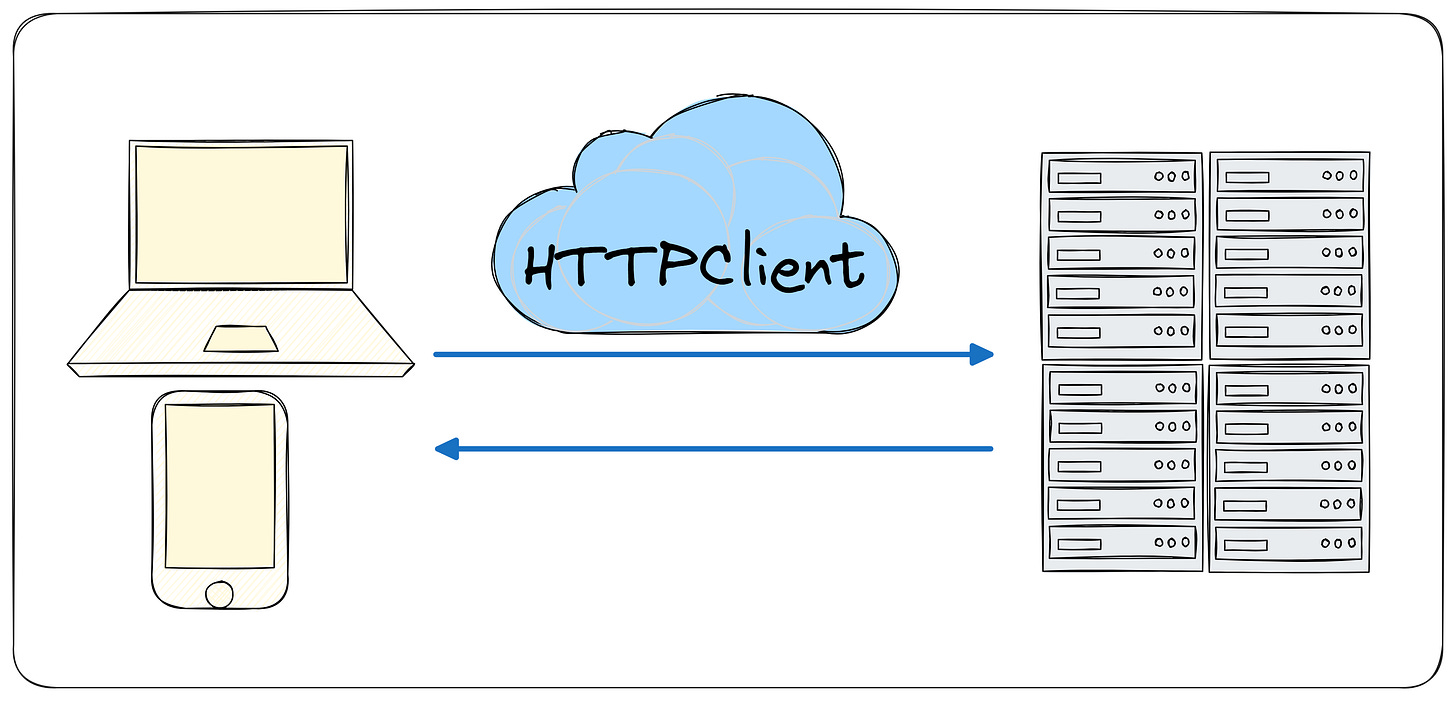🔗 Mastering HTTP Clients in .NET Web API Powerful Ways to Call External APIs
Unlock the Full Potential of HttpClient, IHttpClientFactory, and More
Calling external APIs is a common need in almost every .NET Web API project. Whether you're integrating with payment gateways, external services, or microservices — you need an efficient, scalable, and testable way to perform HTTP operations.
In this article, we’ll cover seven powerful ways to make HTTP calls in .NET using best practices like IHttpClientFactory, Typed Clients, Refit, Polly, and more — with complete working examples. 🚀
1️⃣ Using HttpClient Directly (NOT Recommended for Production)
This is the most basic way to make HTTP requests. However, repeated use of new HttpClient() can lead to socket exhaustion due to improper connection reuse.
public class RawHttpClientService
{
public async Task<string> GetData()
{
using var client = new HttpClient();
var response = await client.GetAsync("https://jsonplaceholder.typicode.com/posts");
return await response.Content.ReadAsStringAsync();
}
}✅ Good for: quick scripts, console tools
❌ Avoid in production web apps
2️⃣ Using IHttpClientFactory (Recommended)
Introduced in ASP.NET Core 2.1, IHttpClientFactory solves HttpClient lifecycle issues and integrates smoothly with dependency injection.
Register:
builder.Services.AddHttpClient();
builder.Services.AddScoped<HttpClientFactoryService>();Use:
public class HttpClientFactoryService
{
private readonly HttpClient _client;
public HttpClientFactoryService(IHttpClientFactory factory)
{
_client = factory.CreateClient();
}
public async Task<string> GetData()
{
var response = await _client.GetAsync("https://jsonplaceholder.typicode.com/posts");
return await response.Content.ReadAsStringAsync();
}
}✅ Recommended for most production scenarios
3️⃣ Named Clients
Named clients allow you to register and configure multiple HttpClient instances with different base URLs and settings.
Register:
builder.Services.AddHttpClient("JsonClient", client =>
{
client.BaseAddress = new Uri("https://jsonplaceholder.typicode.com/");
});Use:
public class NamedClientService
{
private readonly HttpClient _client;
public NamedClientService(IHttpClientFactory factory)
{
_client = factory.CreateClient("JsonClient");
}
public async Task<string> GetPosts()
{
return await _client.GetStringAsync("posts");
}
}✅ Ideal for apps calling multiple external services
4️⃣ Typed Clients
Typed clients provide a clean, testable abstraction over HttpClient. These are strongly typed and fully integrated with DI.
Service:
public class TypedClientService
{
private readonly HttpClient _httpClient;
public TypedClientService(HttpClient httpClient)
{
_httpClient = httpClient;
}
public async Task<string> GetPosts()
{
return await _httpClient.GetStringAsync("posts");
}
}Register:
builder.Services.AddHttpClient<TypedClientService>(client =>
{
client.BaseAddress = new Uri("https://jsonplaceholder.typicode.com/");
});✅ Recommended for clean architecture and SOLID principles
5️⃣ Refit – Declarative HTTP Calls
Refit is a REST client for .NET inspired by Retrofit (Java). It allows you to define your API interface and Refit generates the implementation.
Install:
dotnet add package RefitDefine Interface:
public interface IJsonPlaceholderApi
{
[Get("/posts")]
Task<List<Post>> GetPostsAsync();
}
public class Post
{
public int Id { get; set; }
public string Title { get; set; }
}Register:
builder.Services.AddRefitClient<IJsonPlaceholderApi>()
.ConfigureHttpClient(c => c.BaseAddress = new Uri("https://jsonplaceholder.typicode.com"));Use:
public class RefitService
{
private readonly IJsonPlaceholderApi _api;
public RefitService(IJsonPlaceholderApi api)
{
_api = api;
}
public async Task<List<Post>> GetPosts()
{
return await _api.GetPostsAsync();
}
}✅ Super fast for API consumption
✅ Great for shared SDKs or microservices
6️⃣ Polly — Retry & Resilience for Free
Polly adds resilience features like retry, circuit breaker, and timeout.
Register:
builder.Services.AddHttpClient("RetryClient")
.AddPolicyHandler(HttpPolicyExtensions
.HandleTransientHttpError()
.RetryAsync(3));Use:
public class RetryService
{
private readonly HttpClient _httpClient;
public RetryService(IHttpClientFactory factory)
{
_httpClient = factory.CreateClient("RetryClient");
}
public async Task<string> GetWithRetry()
{
var response = await _httpClient.GetAsync("https://jsonplaceholder.typicode.com/posts");
return await response.Content.ReadAsStringAsync();
}
}✅ Helps avoid failures from flaky networks
✅ Combines well with IHttpClientFactory
7️⃣ RestSharp – For Complex Payloads
RestSharp is another library for making RESTful requests. Offers a fluent API and better multipart/form support.
Install:
dotnet add package RestSharpUse:
public class RestSharpService
{
public async Task<string> GetData()
{
var client = new RestClient("https://jsonplaceholder.typicode.com");
var request = new RestRequest("posts", Method.Get);
var response = await client.ExecuteAsync(request);
return response.Content!;
}
}✅ Great for uploading files, working with custom headers
❌ Extra dependency; avoid unless needed
💬 Conclusion
.NET gives you flexible and powerful options for making HTTP calls — but not all are created equal. For most apps, using IHttpClientFactory with Typed Clients and Polly is the sweet spot. Use Refit when you want speed and simplicity.
✍️ If you found this helpful, follow me for more .NET insights and real-world patterns. Let's keep learning together!
When working with APIs in .NET, HttpClient is the go-to utility for making HTTP calls. But what if you want to log requests and responses? Or add custom headers like correlation IDs or tokens? That’s where DelegatingHandler comes in — a powerful but often underutilized tool in .NET.
I hope you found this guide helpful and informative.
Thanks for reading!
If you enjoyed this article, feel free to share it and follow me for more practical, developer-friendly content like this.



Nice article please keep rocking 🙂
Nice